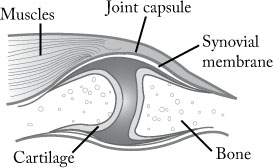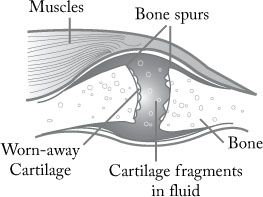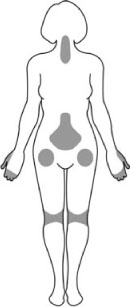The ABC’s of healthy joints
Joints are the places where two moving bones come together. They are perfectly designed to allow smooth motion between the bones and to absorb shock from movements like walking, jumping, lifting and repetitive activities such as typing or playing a musical instrument. The joint consists of: 1) cartilage; 2) the joint capsule – a tough membrane sac that holds the bones and joint parts together; 3) the synovium – a thin membrane inside the joint capsule; 4) synovial fluid, and 5) ligaments, tendons and muscles which keep the bones stable and allow the joint to bend and move. In healthy joints, the ends of bones are encased in smooth cartilage. Together, they are protected by a joint capsule lined with a synovial membrane which produces synovial fluid. The capsule and fluid protect the cartilage, muscles and connective tissue.
Healthy joint

Cartilage: The key to healthy joints
Cartilage is the slippery tissue that covers the ends of bones in a joint. Healthy cartilage allows the bones to smoothly glide over one another without pain or discomfort. It also absorbs energy from the shock of physical movement. It is 65 to 80 percent water. Three other components make up the rest of cartilage tissue: collagen, a fibrous protein, proteoglycans and cells unique to cartilage called chondrocytes. Proteoglycans are a combination of protein and amino-sugar chains. Strands of proteoglycans and collagen weave together and form a water-holding, mesh-like matrix with a consistency much like very firm Jell-O. This allows cartilage to flex and absorb shock. Chondrocytes are found throughout cartilage embedded in this matrix. They are responsible for synthesizing and secreting collagen and proteoglycan, thereby helping cartilage grow and stay healthy. The integrity of the collagen-proteoglycan mesh is crucial for proper joint function and stability. It provides the flexibility and resistance to compression to withstand physical stress.
When good joints go bad
What happens
Cartilage is the part of the joint that cushions the ends of bones. As cartilage breaks down it loses its gel-like nature and its ability to act as a shock absorber. As it wears away, spurs grow out from the edge of the bone and fragments of cartilage fill the synovial fluid. Bones then rub against each other, causing pain, swelling and loss of movement. Joints may ache after physical work or exercise.
A damaged joint

Most commonly affecting middle-aged and older people, pain due to damaged joints can range from very mild to very severe. It affects hands and weight-bearing joints such as knees, hips, ankles and the spine. In the US it is responsible for more than 7 million physician visits per year and is the major source of disability for Americans over 60.

Areas commonly affected
What causes it?
There are many factors that can cause joint pains. Although age is a risk factor, research has shown that it is not an inevitable part of aging. Obesity contributes to damaged cartilage of the knees because of the extra stress on the spine, hips, knees and ankles. Also, people with joint injuries due to sports, work-related activity or accidents may have a higher risk of developing damaged cartilage at joints.
Some people may be born with defective cartilage or with slight defects in the way that joints fit together or how tight they are kept by the ligaments. As a person ages, these defects may cause early cartilage breakdown in the joint. As the cartilage breaks down, inflammation often follows causing further cartilage damage, swelling and pain.
Who is at risk?
Damaged joints is a universal disorder, which means that eventually everyone is at risk. If people live long enough, most will develop some degree of painful joints, especially in their weight bearing joints.
The cellular connection
Glucosamine: The basic building block of cartilage
Glucosamine is an amino sugar (a combination of an amino acid – glutamine, and a sugar – glucose) normally found in healthy cartilage. It is synthesized by many cells in our body but is concentrated in joint cartilage. Glucosamine functions as the basic building block of cartilage by first being a basic building block of glycosaminoglycans (GAG) which themselves make up very large structures known as proteoglycans. Without adequate glucosamine, proteoglycans synthesis by chondrocytes would shut down, and this in turn would cause the synthesis of cartilage to stop. Glucosamine makes up 50% of one of the most important GAGs, hyaluronic acid, which acts as a “glue” that holds cartilage matrix together. Hyaluronic acid is also a critical component of synovial fluid, which lubricates joints and keeps cartilage smooth and healthy.
How does glucosamine work?
Studies have shown that glucosamine stimulates chondrocytes to synthesize more collagen and proteoglycans, the molecules responsible for establishing cartilage matrix and for the resilience of cartilage. Scientists believe that the amount of glucosamine at the joint determines the amount of proteoglycans and collagen produced. The end result would be healthier cartilage. In this way, glucosamine can help the body repair damaged or worn out cartilage. It works at the cellular level to reinforce our natural “repair” ability. Glucosamine has also been shown to inhibit the proteolytic enzymes that are responsible for breaking down cartilage and to have an anti-inflammatory effect in damaged joints.
Where do I get glucosamine?
As mentioned above, glucosamine is manufactured by specific cells that have the ability to combine the amino acid glutamine and the carbohydrate glucose. Some glucosamine also enters the body through the diet from the consumption of animals and fish.
During “the development years,” the body is at its most efficient in terms of glucosamine production and cartilage creation, maintenance, and repair. High production efficiency of glucosamine and cartilage is a necessity for growth and development. Scientists believe that as the body ages its efficiency or capacity for producing glucosamine and ultimately cartilage declines, resulting in prolonged periods where demand for glucosamine production for cartilage regeneration or repair exceeds supply.
When demand exceeds supply!
Throughout our lives there is constant demand on the body to create, maintain, repair, and regenerate cartilage and the glucosamine from which it’s made. As previously mentioned, glucosamine is made in many cells of the body by the biological combining of glucose and glutamine. However, the process is very complicated and as we age the body’s efficiency and capacity to produce glucosamine and thus cartilage can be dramatically restricted. This loss of glucosamine production combined with an increase in demand due to physical activity or age related cartilage degeneration can result in a situation where demand for glucosamine exceeds supply. The result is the pain, stiffness, and loss of mobility.
Does supplementation really work?
Because the body’s complex process of cellular manufacture or biosynthesis results in a circulating “pool” of stable glucosamine in the body, many scientists believe that providing the body with increased amounts “pre-formed” glucosamine will help keep supply ahead of demand and thus stop or even reverse degenerative cartilage loss. Several studies have explored the effects of glucosamine supplementation. Studies documenting the effects of giving subjects a dose of 1500 mg of glucosamine followed the participants over a three-year period and found that glucosamine can slow the breakdown of joint cartilage. Results from double blind, placebo-controlled clinical studies consistently illustrate glucosamine’s role in joint cartilage production. Glucosamine has been shown to slow down or stop the progression of cartilage damage of the knee, finger joints, hip, and spinal disks. Studies have shown glucosamine is also effective in addressing joint stiffness, pain, and decreased range of motion.